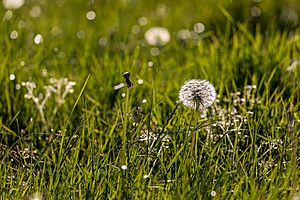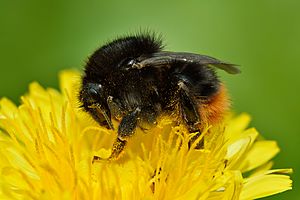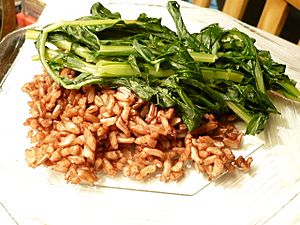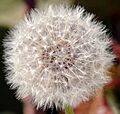Common dandelion facts for kids
Quick facts for kids Common dandelion |
|
|---|---|
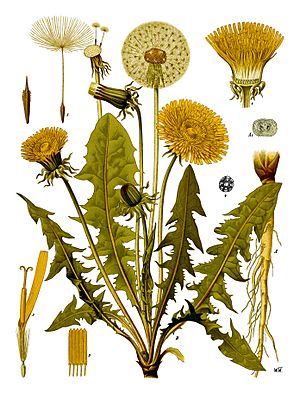 |
|
| Common dandelion | |
| Conservation status | |
| Scientific classification | |
| Genus: |
Taraxacum
|
| Species: |
officinale
|
| Synonyms | |
|
|
The dandelion, also known as Taraxacum officinale, is a common flowering plant. It is a perennial herb, meaning it lives for more than two years and has soft stems. Dandelions belong to the Asteraceae family, which also includes sunflowers.
Dandelions are famous for their bright yellow flower heads. These flower heads later turn into fluffy, round balls. These balls are made of many silver-tufted fruits. Each fruit has a tiny parachute that helps it fly away in the wind. People often call these fluffy balls "clocks" or "blowballs."
You can find dandelions in many temperate regions around the world. They like areas with moist soil. While many people see them as weeds in their lawns, dandelions are also used in herbal medicine and as food. Their leaves, flowers, and roots can all be used.
Contents
What Dandelions Look Like
The dandelion plant grows from a long, thick root called a taproot. It usually has several hollow stems without leaves. These stems can be from 5 to 40 centimeters (2 to 16 inches) tall. Sometimes they can grow up to 70 centimeters (28 inches) tall. The stems might have a purplish color.
Dandelion leaves grow from the base of the plant. They are usually 5 to 45 cm (2 to 18 inches) long and 1 to 10 cm (0.4 to 4 inches) wide. The edges of the leaves are often deeply cut or toothed, like a lion's tooth. This is where the name "dandelion" comes from!
Each stem holds one single yellow flower head. These flower heads are made up of many small flowers called florets. After the flowers bloom, they turn into the familiar fluffy seed heads. The seeds are small and have a white, silky "parachute" on top. This parachute helps the seeds travel far in the wind.
How Dandelions Get Their Name
The scientific name Taraxacum might come from Arabic or Greek words. The word officinale means "medicinal" or "from a pharmacy." This shows that dandelions were known for their healing properties long ago.
The common name "dandelion" comes from the French phrase dent de lion. This means "lion's tooth." It refers to the jagged, tooth-like edges of the dandelion's leaves.
Dandelions have many other old English names too. Some of these include "blowball," "lion's-tooth," "milk-witch," and "monks-head." Some names like "pee-a-bed" or "wet-a-bed" refer to the plant's use as a diuretic, which makes you urinate more.
Where Dandelions Grow
Dandelions are originally from Europe and Asia. They were brought to America a long time ago, possibly as a food crop. Now, you can find them almost everywhere in the world. They grow in North America, South America, Australia, New Zealand, and parts of Africa and India.
These plants like to grow in temperate regions. You often see them in lawns, along roadsides, and in other disturbed areas. They prefer moist soils.
Dandelion Life Cycle and Spread
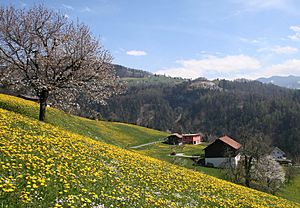
Dandelions are very good at spreading. Their seeds can travel far on the wind. A single dandelion plant can produce over 5,000 seeds in a year! These seeds can stay alive in the soil for many years before they sprout.
The seeds don't need cold weather to start growing. They just need to be near the top of the soil. This helps dandelions quickly grow in new places, like disturbed ground.
Dandelions are also important for insects. Honey bees and other insects visit dandelion flowers to collect pollen and nectar. Even though dandelion pollen isn't the best food for bees, it can be a helpful food source, especially in areas with not many other flowers.
How People Use Dandelions
| Nutritional value per 100 g (3.5 oz) | |
|---|---|
| Energy | 188 kJ (45 kcal) |
|
9.2 g
|
|
| Sugars | 0.71 g |
| Dietary fiber | 3.5 g |
|
0.7 g
|
|
|
Protein
|
2.7 g
|
| Vitamins | Quantity
%DV†
|
| Vitamin A equiv.
beta-Carotene
lutein zeaxanthin
|
64%
508 μg
54%
5854 μg13610 μg
|
| Thiamine (B1) |
17%
0.19 mg |
| Riboflavin (B2) |
22%
0.26 mg |
| Niacin (B3) |
5%
0.806 mg |
| Pantothenic acid (B5) |
2%
0.084 mg |
| Vitamin B6 |
19%
0.251 mg |
| Folate (B9) |
7%
27 μg |
| Choline |
7%
35.3 mg |
| Vitamin C |
42%
35 mg |
| Vitamin E |
23%
3.44 mg |
| Vitamin K |
741%
778.4 μg |
| Minerals | Quantity
%DV†
|
| Calcium |
19%
187 mg |
| Iron |
24%
3.1 mg |
| Magnesium |
10%
36 mg |
| Manganese |
16%
0.342 mg |
| Phosphorus |
9%
66 mg |
| Potassium |
13%
397 mg |
| Sodium |
5%
76 mg |
| Zinc |
4%
0.41 mg |
| Other constituents | Quantity |
| Water | 85.6 g |
|
Link to USDA Database entry
|
|
| †Percentages estimated using US recommendations for adults. | |
Dandelions have many uses, from food to medicine.
Dandelions as Food
All parts of the dandelion plant can be eaten!
- Leaves: Young dandelion leaves, called "dandelion greens," can be eaten raw in salads. Older leaves are often cooked, like spinach or mustard greens. They have a slightly bitter taste. Dandelion greens are full of vitamins A and C, as well as iron, phosphorus, and potassium.
- Flowers: The bright yellow flowers can be used to make dandelion wine. They can also be used to make a sweet syrup that tastes like honey.
- Roots: The roots can be roasted and ground into a powder. This powder can be used as a coffee substitute that doesn't have caffeine.
Dandelion and burdock is a popular soft drink in the United Kingdom.
Dandelions in Medicine
Dandelions have been used in traditional medicine for thousands of years. People in Europe, North America, and China have used them. One common use is as a diuretic, which helps the body remove extra water. This is why one French name for dandelion, pissenlit, means "wet the bed."
Other Uses for Dandelions
The flowers of dandelions can be used to make yellow dyes. The milky sap inside the plant can even be used as a type of glue.
Images for kids
See also
 In Spanish: Diente de león para niños
In Spanish: Diente de león para niños



